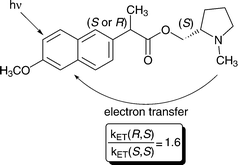Intramolecular electron transfer in diastereomeric naphthalene–amine dyads: a fluorescence and laser flash photolysis study†‡
Abstract
Two dyads containing a

- This article is part of the themed collection: In honour of Hiroshi Masuhara
* Corresponding authors
a
Instituto de Tecnología Química, UPV-CSIC, Universidad Politécnica de Valencia, Av. de los Naranjos s/n, Valencia, Spain
E-mail:
mmiranda@qim.upv.es
Fax: +34 96 387 78 09
Tel: +34 96 387 78 07
b
CEQUP/Departamento de Química, Faculdade de Ciências, Universidade do Porto, Rua do Campo Alegre, Porto, Portugal
E-mail:
upischel@fc.up.pt
Fax: +351 22 608 29 59
Tel: +351 22 608 28 85
Two dyads containing a

 Please wait while we load your content...
Something went wrong. Try again?
Please wait while we load your content...
Something went wrong. Try again?
S. Abad, U. Pischel and M. A. Miranda, Photochem. Photobiol. Sci., 2005, 4, 69 DOI: 10.1039/B409729G
To request permission to reproduce material from this article, please go to the Copyright Clearance Center request page.
If you are an author contributing to an RSC publication, you do not need to request permission provided correct acknowledgement is given.
If you are the author of this article, you do not need to request permission to reproduce figures and diagrams provided correct acknowledgement is given. If you want to reproduce the whole article in a third-party publication (excluding your thesis/dissertation for which permission is not required) please go to the Copyright Clearance Center request page.
Read more about how to correctly acknowledge RSC content.
 Fetching data from CrossRef.
Fetching data from CrossRef.
This may take some time to load.
Loading related content
